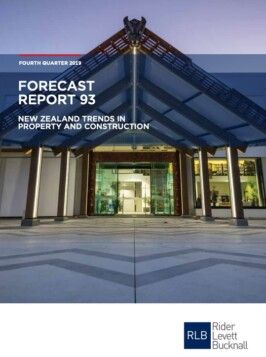The Rider Levett Bucknall (RLB) Forecast 93 report – New Zealand Trends in Property and Construction – released today confirms that solid population growth should continue to underpin construction demand.
Prepared by the New Zealand Institute of Economic Research (Inc.) (NZIER) exclusively for RLB, Forecast 93 noted that across the regions, Auckland continues to have the dominant share of total construction activity. Demand for retail outlets and storage buildings in the region has been strengthening over the past year.
Auckland population growth strong
According to RLB Director, Grant Watkins, ‘Given population growth has been particularly strong in Auckland, we expect the region will continue to drive overall construction demand.’
‘Although Canterbury’s share of construction activity in New Zealand has fallen over the past year, consent issuance nonetheless points to stronger construction demand. This should flow through to activity over the coming year,’ he continued.
Grant added, ‘In contrast, residential construction in Wellington has been surprisingly flat over the past year, despite the surge in Wellington house prices.’
Net migration continues to rise in New Zealand
New Zealand’s new passport-linked measure of permanent arrivals and departures requires provisional estimates to be made which makes the net migration data prone to revisions in the subsequent months. The number of people coming into the country continues to rise, but this has been partly offset by a modest increase in the number of people leaving the country. This migration-led population growth should continue to support construction demand over the coming year.
Demand shifts to medium and high density housing
There has been a shift in construction demand towards medium and high-density housing. This trend has been particularly apparent in Auckland, as more acute infrastructure constraints boosted demand for centrally-located dwellings in the region.
Although standalone houses remain the most popular form of dwelling, there has been a surge in consent issuance for multi-unit dwellings over the past year, particularly townhouses and flats.
Non-residential building consents easing
According to RLB, there has been a slight easing in non-residential construction consent issuance in more recent months, but demand remains high and close to the levels seen in the previous building boom in 2008.
The measure of value of consent issuance per square metre, which is considered a proxy of construction cost pressures, has lifted. This suggests construction cost escalation remains high, reflecting continued capacity pressures in the construction sector.
Non-residential construction demand over the past year has been particularly strong for accommodation. Growth in both the number of people living in and visiting New Zealand show signs of easing, and this will likely start to weigh on demand for this type of non-residential construction over the coming years.
Decline in demand for education and health facilities
Grant continued, ‘According to RLB, social buildings, hostels and storage buildings were the top three drivers of growth in non-residential construction consent issuance over the past year. In contrast, demand for education and health facilities, as well as farm and office buildings declined over the past year.’
‘Meanwhile, the decline in demand for new office developments follows strong growth in recent years. Looking ahead, earthquake strengthening activity should continue to contribute to non-residential construction demand,’ he said.
Non-residential construction demand in Canterbury and Waikato picks up
Non-residential construction demand in Auckland has eased in recent months, but demand still grew over the past year and it remains the dominant driver of non residential construction activity.
Non-residential construction demand in Canterbury picked up strongly over the past year, reflecting increased demand for social buildings, hostels and education facilities in the region.
Stronger demand for hostels also drove the growth in non-residential construction demand in Waikato.
RLB expects the effects of strong population growth will continue to drive relatively strong non-residential construction demand in Auckland over the coming years.
FURTHER INFORMATION:



